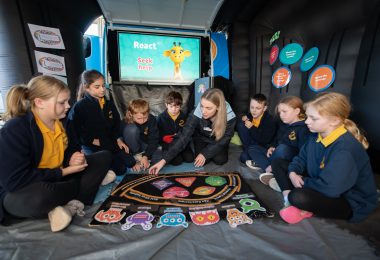Getting The Kids Moving Together

According to the national guidelines, school-age kids should get at least an hour of exercise every day.
It’s also recommended that children aren’t sitting around for longer than 2 hours at a time. But what types of activity are best for our kids and how much is too much?
Why is exercise so important?
Exercise is important to help build strong muscles and bones. Regular physical activity can help guard against obesity, type-2 diabetes and high blood pressure.
Being active can also be great to help boost mood and self-esteem. Kids who are physically fit also tend to sleep better.
And when they’re out and about being active, they’re not playing computer games, nor are their eyes glued to a screen.
Why do kids want to exercise?
We spoke to a number of families about the physical activities their children were involved in and what motivated them to keep going. Some kids were super committed and competitive, while others were more interested in the social aspect, but everyone we spoke to was in it for the fun.
What are the best ways to get kids moving?
Organised sports, such as tennis, soccer, cricket, basketball, gymnastics and swimming lessons are big these days.
Some are team sports, while others are individual ones, and all can have their benefits. When it comes to team sports, one mum said she wants her daughter to learn about working together and supporting each other.
“I want her to do a team sport for the social side. I think it’s important to grow up and learn about the dynamics of a team rather than just wanting to win for yourself,” she said. “In a team, you have to understand that what you do has an impact on other people and what they do has an impact on you. You can get a great feeling of belonging when you’re part of a team.”
Another mum spoke about the importance of building good sportsmanship through team-based activities.
“When my boys were smaller there used to be a lot of tears if the game didn’t go to plan. Over time they have learnt to manage their emotions better, winning and losing more gracefully.”
Not everyone likes team sports though. Individual sports, like tennis or martial arts, can also be great for boosting self-esteem, as skill levels grow and milestones are accomplished.
As well as improving flexibility, strength and coordination, these sports can also have varying levels of competition.
Are we over-doing it?
Are our kids’ schedules actually a bit too busy? One of the dads said, “I have a nagging concern that too much of their activity is planned. I’d like to drop an activity and allow for more free play. I want them to remember how to occupy themselves, without the need to be entertained. I want to avoid them sitting back and waiting for something to happen.”
Fun activities like riding a bike, swimming, playing a game or walking a neighbour’s dog can happen at any time of the day. It’s also a nice unstructured way for the family to spend time together.
One mum told me “If we’re at home we’d all be in different rooms doing our own thing. So getting out of the house is something we can all do together. We’re also more likely to talk and laugh – it’s a fun time.”
Integrating exercise as part of your regular routine is not only great for the kids, it’s a fantastic way to catch-up as a family. As the weather gets warmer, make a habit of going for a before or after dinner walk around the neighbourhood. This is also a great way to encourage conversation and find out what’s going on with everyone, as well as give a friendly wave to your neighbours.
How can you choose the best activity for your child?
Parents recommend asking questions such as:
1. What does your child like doing?
Do they like running or dancing? Do they want to be the next hero on the rugby field or do their own thing on a bike? If they want to play nonstop rather than changing roles and taking turns, perhaps tennis might suit them more than cricket.
2. What do they need?
Perhaps they need a confidence boost? If so a martial art like Tae Kwon Do might be an option. Or maybe it’s flexibility they need to work on in a gymnastics studio?
3. Is there a balance between organised sports and active free play and family time?
Or do you feel you are a slave to the schedule, always ‘taxiing’ from one activity to the next and refuelling on the run?
4. Do they have a passion for something?
It’s great to be exposed to multiple options for exercise from an early age, but no one ever became good at something without commitment, perseverance and practice. Logistical complexity and cost aside, perhaps it makes sense to focus on fewer activities that are the real favourites.
5. How can you best support them?
Kids love encouragement from the sidelines or when practising at home. Parental support and involvement can be a big boost to self-esteem and role modelling good sportsmanship can be hugely influential too.









